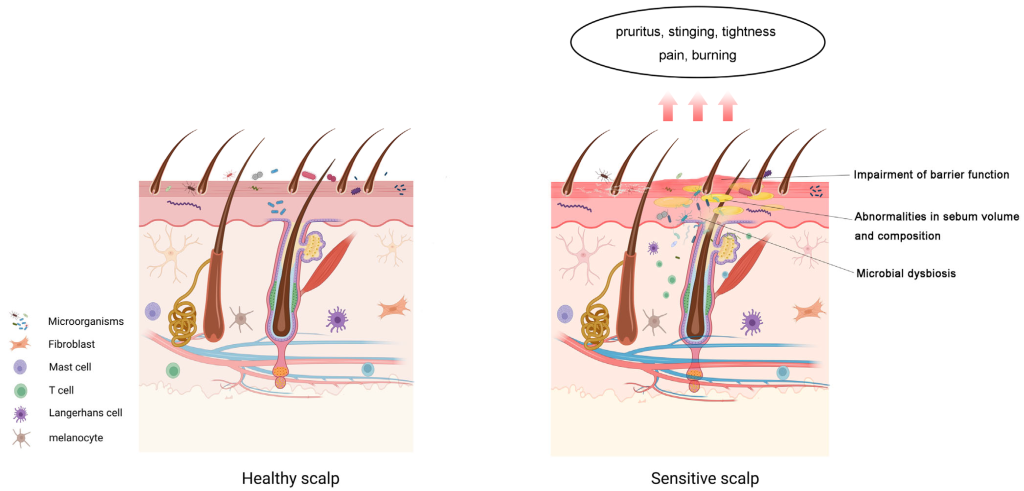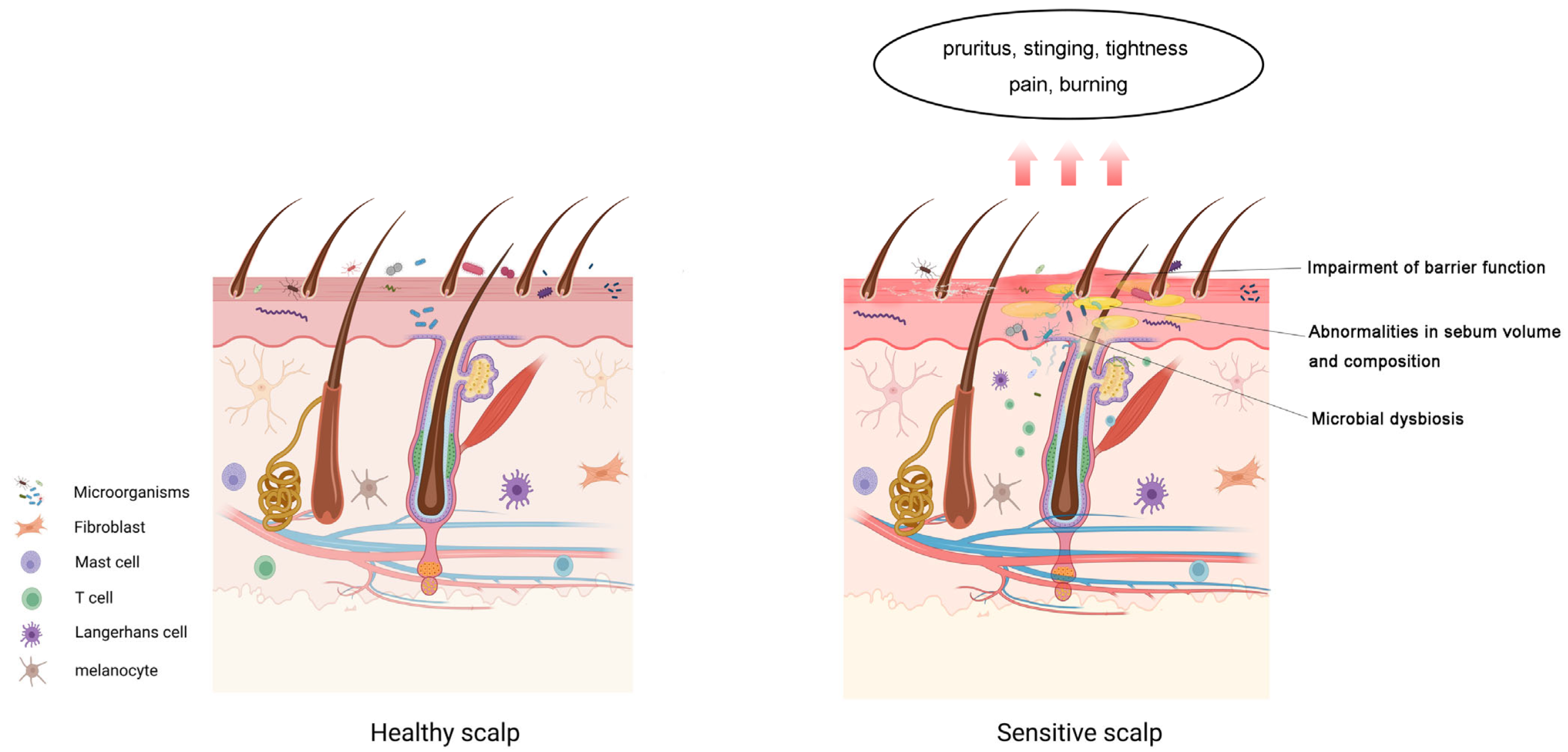Sensitive scalp (SSC) represents a frequent yet often overlooked dermatological state. It is primarily defined by the occurrence of abnormal and unpleasant sensory reactions—such as pruritus (itching), stinging, tightness, pain, and burning sensations—in response to typical environmental stimuli. These sensations are classified as primary sensitive scalp (Primary SSC) when they occur in the absence of obvious visible clinical inflammation or known underlying skin diseases. The scalp is particularly susceptible to sensitivity due to its characteristics, including thin skin and a rich concentration of sebaceous glands, blood vessels, and nerves.
The onset of SSC is multifaceted, implicated by a variety of intrinsic and extrinsic triggers, including physical factors (e.g., UV radiation, temperature changes), chemical factors (e.g., cosmetic ingredients), and psychological factors (e.g., emotional stress). Despite its prevalence, which epidemiological studies estimate ranges widely from 30% to 56%, the mechanistic understanding of SSC remains incomplete, with many insights often extrapolated from studies concerning sensitive skin on other body sites. Furthermore, the current methods for evaluating SSC rely heavily on subjective self-reported questionnaires, which are susceptible to bias and underscore a critical need for objective diagnostic criteria. To address these gaps and support the development of effective protective strategies, the authors undertook this comprehensive literature review. The review specifically proposed that disruption of the scalp barrier—driven by imbalances in sebum, lipid metabolism, and the microbiome—may be a key factor in SSC development, thus positioning advanced research approaches like lipidomics and microbiomics as necessary future tools for elucidating the complex pathophysiology.
Methods
This work constituted a narrative review of the current research on sensitive scalp (SSC). The literature analyzed spanned publications from 1963 to 2024. Sources were retrieved from major academic databases including PubMed, Elsevier, and Web of Science. The review synthesized hallmark symptoms, available evaluation methods, potential mechanisms, contributing factors, and management strategies related to SSC. The focus was predominantly on primary sensitive scalp, though secondary causes were referenced for context.
Key Findings
• Symptoms: The primary and most frequently reported symptom of SSC is pruritus (itching), alongside other common sensations such as stinging, tightness, pain, and burning.
• Evaluation Challenges: Current assessment methods for SSC are predominantly subjective and constrained by self-reporting limitations. Commonly used tools include the four-grade self-assessment scale, the 3S questionnaire (which quantifies severity based on a 0–20 total score), and the 10Q questionnaire (which focuses on identifying associations with 10 environmental triggers).
• Barrier Dysfunction: SSC is strongly associated with scalp barrier dysfunction. This dysfunction may involve compromised barrier integrity, altered skin surface lipids (SSL) composition, and microbial dysbiosis. Findings suggest SSC may be accompanied by increased pH, higher sebum secretion, and changes in the microbiome, particularly an increase in Propionibacterium.
• Prevalence and Gender: The prevalence of SSC is consistently reported to be significantly higher in women than in men across various studies.
• Age Trend: The prevalence of SSC appears to increase with advancing age, potentially linked to neurodegeneration, long-term exposure to irritants, and a decline in stratum corneum lipids like ceramides.
• Triggers: Key exogenous and endogenous triggers identified include:
◦ Psychological Factors: Emotional fluctuations and stress are major triggers that may impair barrier function through activation of the HPA axis.
◦ Cosmetic Products: The use of hair conditioners and shampoos frequently exacerbates SSC symptoms. Harsh cleansing habits or certain ingredients (e.g., surfactants, preservatives, fragrances) can damage the scalp barrier.
◦ Environmental Factors: High temperatures and solar ultraviolet (UV) radiation are identified as primary triggers. Elevated temperatures can enhance sebum secretion, promoting the growth of microorganisms like Cutibacterium acnes and Malassezia, leading to inflammation.
This literature review reinforces that Sensitive Scalp (SSC) is a complex condition characterized by subjective discomfort and a strong association with impaired scalp barrier function. The novelty of this research lies in its emphasis on the need to move beyond epidemiological observations and subjective assessments by integrating modern analytical techniques. The authors explicitly highlight that current mechanistic insights are preliminary and largely extrapolated, thereby underscoring the potential of lipidomics and microbiomics to fundamentally advance the field.
The future implications of this research are focused on precision dermatology. Future studies are directed toward characterizing the specific lipidomic profiles associated with SSC and examining the dynamic changes in the scalp microbiota during disease progression. By understanding how these lipid and microbial alterations modulate the scalp barrier and trigger inflammation at a molecular level, researchers aim to establish a more solid theoretical foundation for developing targeted treatments, facilitating precision scalp care, and ultimately improving the quality of life for individuals suffering from sensitive scalp syndrome.
Link to the study: https://www.mdpi.com/2079-9284/12/6/239


